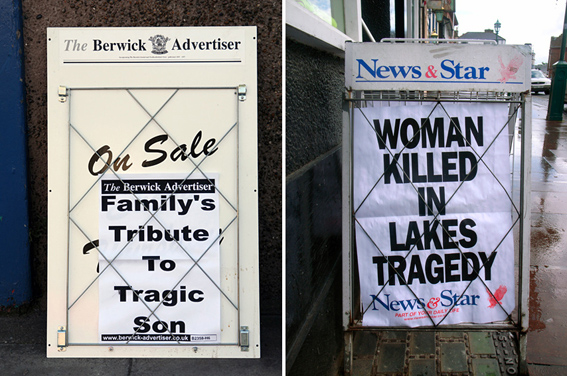One of the things I noticed most after returning to England after a year in Russia were the seasons. In Russia we experienced either winter or summer, and very little in between.
Here’s a short poem by the English poet, painter, and printmaker, William Blake, in celebration of Autumn!
To Autumn
by William Blake (from Poetical Sketches, 1783)
O Autumn, laden with fruit, and stain’d
With the blood of the grape, pass not, but sit
Beneath my shady roof; there thou may’st rest,
And tune thy jolly voice to my fresh pipe,
And all the daughters of the year shall dance!
Sing now the lusty song of fruits and flowers.
“The narrow bud opens her beauties to
The sun, and love runs in her thrilling veins;
Blossoms hang round the brows of Morning, and
Flourish down the bright cheek of modest Eve,
Till clust’ring Summer breaks forth into singing,
And feather’d clouds strew flowers round her head.
“The spirits of the air live in the smells
Of fruit; and Joy, with pinions light, roves round
The gardens, or sits singing in the trees.”
Thus sang the jolly Autumn as he sat,
Then rose, girded himself, and o’er the bleak
Hills fled from our sight; but left his golden load.
Posted in MISCELLANEOUS, POETRY | Comments Off on TO AUTUMN
 
© Wendy Pye
Interestingly there’s an article in today’s Observer newspaper by Geraldine Bedell (The spectral memorials that haunt our roads) exploring the phenomenon of ghost bikes, which I coincidently wrote about in the blog last week. The article features a series of photographs by Katherine Rose of ghost bikes shot at night.
Spectre is also the title of an exhibition in the Brighton Photo Fringe featuring work by the photographers Karen Grainger, Wendy Pye, Toby Smith, Jackie Castellano, Kristy Gosling, Richard Kolker and Adrian Wood.
The exhibition explores several subjects surrounding the theme of the ‘Spectre’ and includes “the social impact of online virtual escape worlds, video work exploring the relationship between depression and perception, undercover cold war archaeology, the aging process and photography’s more conceptual relationship with death and the ghost.”
I’m particularly interested in seeing the work of Wendy Pye, which explores the landscape of Beachy Head, a beauty spot in Sussex and notorious location for people attempting suicide. The image above shows flowers left at the scene of a suicide, photographed at night.
You can find out details of the exhibition on this dedicated website.
Posted in MISCELLANEOUS, PLACES | Comments Off on THE SPECTRE
Just a quick plug for an exhibition I have opening tonight as part of the Brighton Photo Fringe, part of the Brighton Photo Biennial. I’m exhibiting some landscapes from Motherland alongside New York-based photographer, Rosa Ugarte.

More details here. All welcome!
Posted in MISCELLANEOUS | Comments Off on GREENLAND, MOTHERLAND
September 27th, 2008 admin
A reader of the blog emailed me today to suggest I looked at roadside memorials as part of the project-
“Dear Sir,
This may seem macabre but there is a whole book just waiting to be written whose subject would be the shrines which have sprung up on roadsides where a loved one has been killed in an accident. Some are attended more regularly than many a grave, with floral tributes frequently restored. Others have grown to iconic proportions with photos and the deceased’s number plate.
All have a tale to tell I’m sure. For starters, if it’s still there, look near the lay by on the A628 near Woodhead between Glossop and Barnsley (the Woodhead pass). It’s just before the lay by which is more like an old quarry entrance and has a snack bar trailer in it. The shrine is in a very dangerous section.”
Although not something I intend covering for We English, I think it’s worth a mention on the blog, especially following on from my post Death, Read All About It, last week.
During our travels we did come across a large number of roadside memorials marking the location of fatal road accidents. These shrines, marked with plaques, wooden crosses and flowers, are considered not only an appropriate but also an expected response to tragedy.
Â
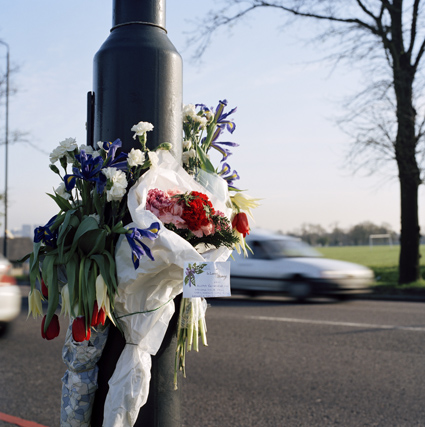
Roadside Memorial, Purley Way, Croydon
The card reads “In Loving Memory, Von – Always Remember You and Always Love, from Cary, Maggie, Chris, Ruth, Lesley and family.”
According to Brake, the road safety charity, while many local authorities are happy for small memorials to be placed at the roadside, some authorities object to permanent memorials, even small ones, and even go as far as restricting the length of time that flowers can be placed at the scene of a crash. Dr Una MacConville from the Centre for Death & Society at University of Bath has undertaken research into these ‘spontaneous shrines’, as she refers to them. She claims that these restrictions are for “health and safety reasons” and authorities are claiming they are acting on foot of advice from the police who fear the tributes, many near dangerous roads, could distract motorists. These restrictions have been considered “crass and insensitive” by bereaved families and road safety campaigners, some of whom feel these memorials are being removed in order not to draw attention to the death toll on certain roads.
One of the most interesting phenomenon related to roadside memorials has been the appearance of Ghost Bikes around England, and abroad. Ghost Bikes are small and somber memorials for bicyclists who are killed or hit on the street. A bicycle is painted all white and locked to a street sign near the crash site, accompanied by a small plaque. The first ghost bikes were created in St. Louis, Missouri in 2003, and they have since appeared in at least 62 cities throughout the world.Â
Â
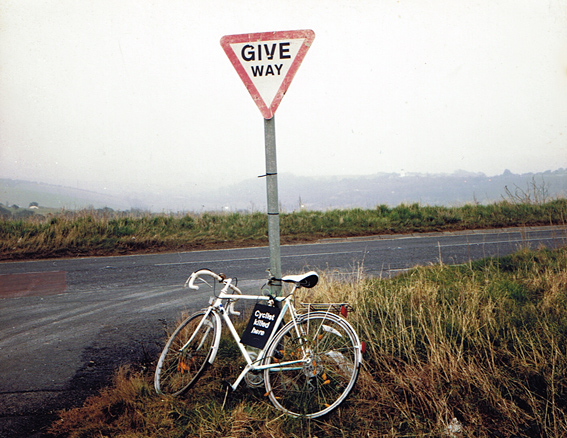
Ghost bike, Brighton
James Danson-Hatcher, 23, was fatally injured when he was hit by a car travelling at about 60mph near a Brighton beauty spot. The accident happened at the junction of Saddlescombe Road and Devil’s Dyke Road, on the outskirts of Brighton, at about 5.30pm on April 5. Mr Danson-Hatcher, was riding home after a visit to Devil’s Dyke when he was hit by a Fiat Bravo. A recent inquest inquest into the accident heard Mr Danson-Hatcher, who had ambitions to be a professional photographer, was described by his family as a competent and experienced cyclist who regularly rode to Devil’s Dyke to cycle across the Downs. His father told the hearing cycling was his son’s main means of transport and leisure activity and said it was a “cruel irony” he died while on his bike.
As the Ghost Bike website quotes “the bikes serve as reminders of the tragedy that took place on an otherwise anonymous street corner, and as quiet statements in support of cyclists’ right to safe travel.”
Posted in MISCELLANEOUS, ON THE JOB | 2 Comments »
September 22nd, 2008 admin
Wherever possible I bought a copy of the local newspaper in all the places we visited in order to explore the context within which my photographs were taken. More about this in a later post. For now, I want to talk about how visual media has become integral to our exposure to representation of death.Â
Over the course of a year I photographed newspaper billboards, mostly around London where I was living at the time, which dealt with the subject of death. With all these headlines the topic of death, often described in grizzly soundbites, was used to sell our daily news. Headlines such as: “Man’s Head Cut Off In DLR Train Horrorâ€, “Baby Savaged To Death By Dogâ€, “Victim of Black Magical Sex Killer†and “Shallow Grave Woman Battered To Death.†In some cases, we are also tempted by the fact that photographs are available: “McVeigh Ready to Die – Picturesâ€, “Child Victims Of Suicide Bomber – Picture†and “Hanratty Body Exhumed – Picture.â€
I collected forty-nine headlines and created a composite the shape and size of a newspaper billboard. My intention had been to the place them in Evening Standard billboards around London, however, I got cold feet, worried about being prosecuted!
Here is a small version of the composite-
Â
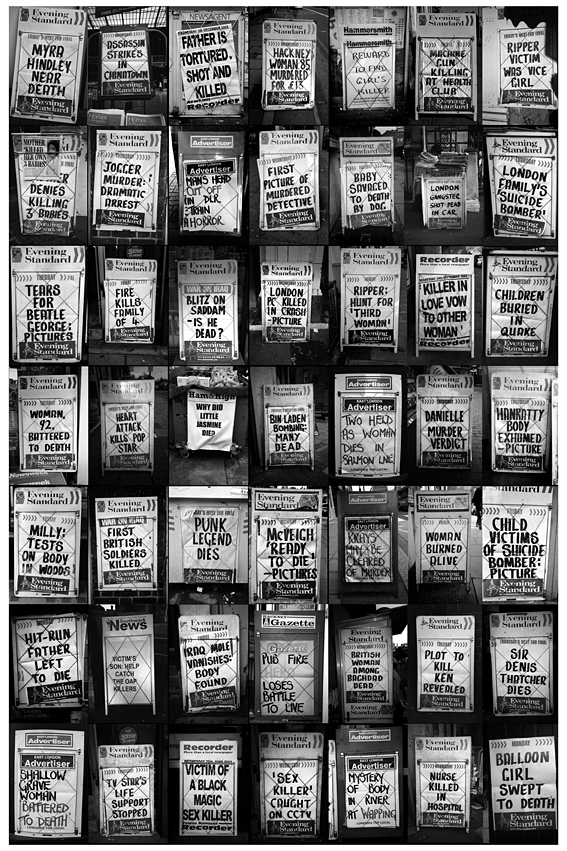
The aim was to explore how death is portrayed as entertainment, as sound bites and soap opera. This interplay between private and public experience often confers a false sense that we are sharing the drama of death in other people’s lives, while in reality we are completely insulated from it.Â
Posted in MISCELLANEOUS, RESEARCH | Comments Off on DEATH, READ ALL ABOUT IT
September 22nd, 2008 admin
Although a convert to life on the road, with another baby on the way, it’s time to sell our home of the last five months. If you want more details/photographs, give me a call.
TALBOT SWIFT CAPRI 520 GXL, 1993
£9750.00 ono
Â
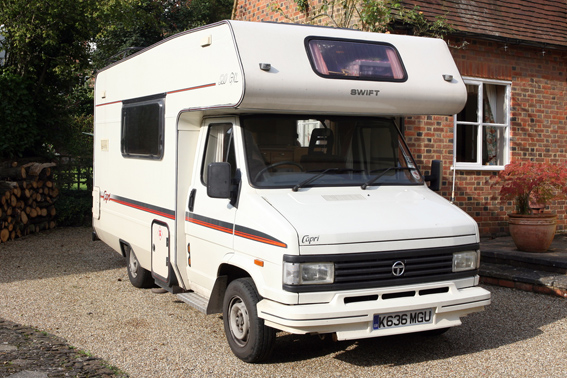
49,000 miles, 5 Speed Manual, Diesel, 2+2 Berth, Overcab Bed, Side Kitchen with Oven, Grill, 4 Burner Hob, Sink, 3-way Fridge, Rear Washroom with Cassette Toilet, Shower, Hand Basin, Wardrobe, Leisure Battery, Mains Hook Up, Zig Unit, Hot Water, Heater, 3 x Lapbelts, Carpets/Upholstery Good Condition, Sunblind, Rear Ladder to Topbox, Bike Rack, Tow Bar, TV Aerial, 6 Month Warranty.
ps. I’ll supply some new hubcaps!
Posted in MISCELLANEOUS | Comments Off on ONE CAREFUL OWNER!
September 19th, 2008 admin
While I’m not generally a fan of photography compendium’s, I recently picked up Image Makers, Image Takers by Anne-Celine Jaeger and found some of the quotes to be quite revealing. The first section of the book is broken up into interviews with photographic artists, working within the disciplines of fine art, documentary, fashion, advertising and portraiture, where they are asked about what inspires them, the balance of technique and gift and the process of artistic creation. The second section has picture editors, curators, agency directors and art book publishers interviewed about what they look for in an image.
Â
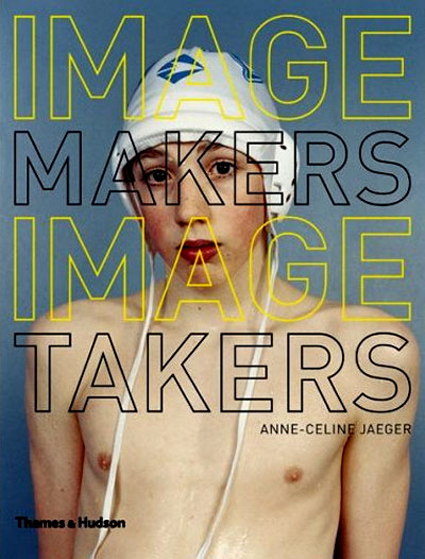
Here are some of the quotes-
William Eggleston is asked “How do you decide if something is worthy of being captured?”
“I never know beforehand. Until I see it. It just happens all at once. I take a picture very quickly and instantly forget about it. Not for good, but for the time being. Suddenly I just feel like I have to take a picture. Sometimes I’ll leave the house with a fully loaded camera and end up with nothing. It’s just about being there. Anywhere. Even the most uninteresting, ugly or boring places can for an instant become magical to me.”
William Eggleston quotes Garry Winogrand-
“When someone asked him why he took pictures, Garry said, ‘Because I want to see what something looks like when it’s photographed.'”
Stephen Shore is asked “Do you need a philosophy to do great work?”
“I would call it ‘intentionality’. Sometimes I meet young artists and it becomes clear that for some the main motivation is getting a show in Chelsea. It strikes me that this is very different to the way it was for me, which was that I wanted to understand photography and the world and myself. To do that, I produced work. The work that was shown was like a by-product, but never the purpose of my photography. The thought process doesn’t even have to be conceptual or intellectual. It can be visual, or a layer of thought that’s wordless. I’m always exploring some question or other, but it may not even be formulate as such. I believe the work produced by most established artists, was produced as a by-product of their personal explorations.”
Eugene Richards is asked “Do you see yourself more as a photographer or a journalist?”
“I go out into the world as a photographer, but I were to tell the truth, if I could become a very fine writer, I wouldn’t need to take photographs any more.”
David LaChapelle is asked “Do you think you can learn a way of seeing?”
“I think you either have it or you don’t. If you have it, you have to discipline yourself to prove it.”
Alec Soth is asked “Are you ever in the situation where you think I’m not sure that was in focus but you have to let it go?”
“All the time. It’s the bane of my existence. I miss pictures all the time. It kills me. But I’m technically better now and I also shoot more film, so I have better odds. I also have this problems that I try to get too much into a picture. I have to remind myself that photography is about limitation. It’s about not having everything there.”
William Eggleston is asked “What goes through your mind when you are framing a shot”?
“Nothing really. It happens so fast. I compose very quickly and without thinking, but conciously. I take a picture instantly and never more than one. Sometimes I worry about the picture being out of focus, but I take the chance. A long time ago, I would have taken several shots of the same thing, but I realised that I could never decide which one was the best shot. I thought I was wasting a lot of time looking at the damn near identical pictures. I wanted to discipline myself to take only one picture of something, and it didn’t work out, that’s just too bad. But it’s pretty much always worked.”
Martin Parr is asked “What are you thinking about, for example, when you are taking a picture in New Brighton of a young mother and kids eating chips opposite an over-flowing dustbin?”
“I’m thinking, ‘Here’s a family on their day out and the litter is spewing over because it’s a bank holiday weekend.'” (!?)
Posted in MISCELLANEOUS | 3 Comments »
September 14th, 2008 admin
We’ve made it! Well nearly. We’ve just pulled in to Oxted for Sunday lunch at my parents. This marks a psychological end to our journey. We’ll be back home to Brighton tomorrow. At this point, I want to pay a small tribute to Sarah and Jemima for enduring four months on the road, living in a confined space while putting up with an obsessive photographer. They coped admirably, especially Sarah who is now 34 weeks pregnant!
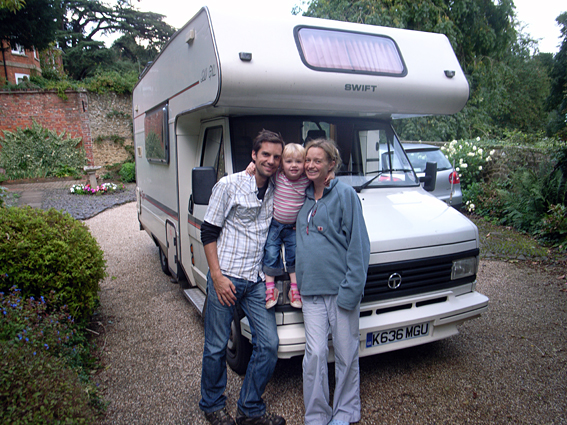
Â
Although it’s not particularly clear, you can get a sense of the ground that we covered in the map below -the ticks mark the places we stayed and/or where I photographed.Â
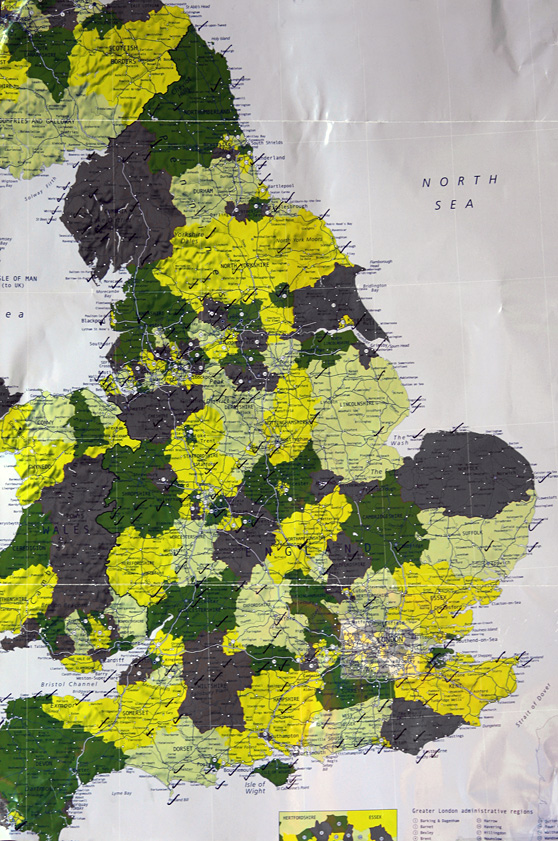
Â
Apologies to anyone from Cornwall, which has somehow managed to get chopped off the map! The only county that we didn’t visit is Buckinghamshire. Fear not, I will make a point of going there in the coming weeks. I’m actually going to continue shooting until the end of 2008, but this will be on a much more targeted basis once I’ve had a chance to edit the material I’ve already shot.
Posted in MISCELLANEOUS, TRIP LOGISTICS | Comments Off on HOME SWEET HOME
September 13th, 2008 admin
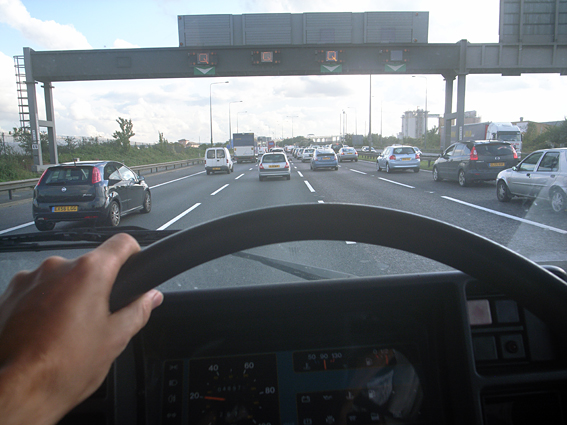
Who on earth came up with the idea that we should spend thousands of pounds of tax payers money putting up signs with the letter Q above our motorways? I can see I’m in queue, I don’t need an illuminated letter telling me that.
Posted in MISCELLANEOUS | Comments Off on Q
September 12th, 2008 admin
We’ve made a slight diversion from the A1 and headed east to north Norfolk to visit Holkham, officially Sarah’s favourite spot in England!
While in the area I took the opportunity to call in on photographer Harry Cory Wright in his Saltwater Gallery. I was interested in meeting Harry as he recently undertook a similar endeavour. In March 2006, Harry took his large-format plate camera, and family, on a trip around the Britis Isles. Beginning in Unst in Shetland at the spring equinox, he travelled down through the Western Isles and mainland Scotland to Northumberland and further south through England and Wales. Merrel have just published the results in the book Journey Through the British Isles.
Â
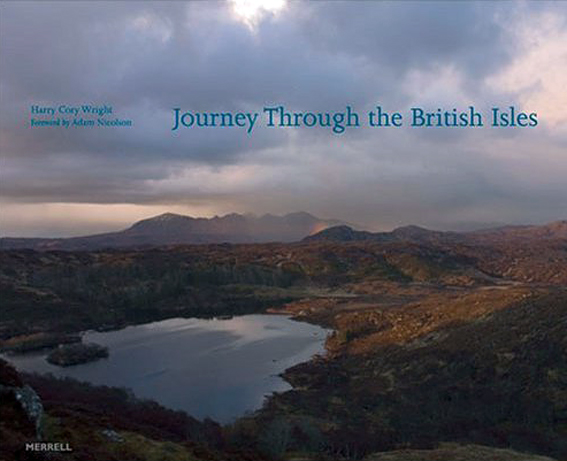
Â
You can read extracts from the blog Harry produced during his journey on The Times website here.
Â
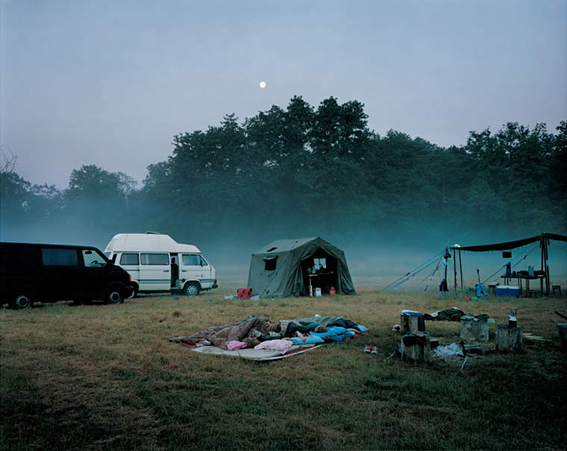
Camp at Tilhill © Harry Cory Wright
Posted in MISCELLANEOUS, RESEARCH | Comments Off on JOURNEY THROUGH THE BRITISH ISLES






